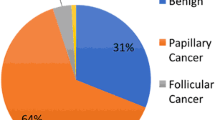Abstract
Serial weekly serum samples (for 3 weeks) were obtained from 42 patients with differentiated thyroid cancer (DTC, papillary no.=35, follicular no.=6, Hürthle cell no.=1) for serum thyroid hormone, TSH and TG before and after total thyroidectomy. Serum specimens were also obtained one month after radioiodine (131I) therapy followed by suppressive dose of L-thyroxine (L-T4, 2.5 μg/kg). The patients were subdivided into four groups: group I: the DTC was confined to a single solid nodule (no.=12); group II: thyroid malignancy invaded local cervical structures but there were no lymph node metastases (no.=8); group III: DTC with lymph node metastases (no.=6); and group IV: DTC with distant metastases (no.=16). In all group I patients serum TG remained undetectable in spite of elevated serum TSH levels at the 3rd week post-surgery (PS). Only one of group II patients had a detectable serum TG value of 5.2 ng/ml (3rd week PS). By contrast, 37.5% of group III patients had detectable serum TG levels, ranging from 3.4 to 16.8 ng/ml (3rd week PS). Lymph node metastases were detected in 5 of these patients by whole body scan (WBS) and removed surgically in 3. As expected, group IV patients had elevated serum TG values ranging 33.0–958.0 ng/ml and distant metastases were confirmed in all of them by WBS. From the calculations through univariate logistic regression comparing TG concentrations at the 3rd week PS from groups I and II vs groups III and IV, we obtained a cut-off value of 2.3 ng/ml with the following efficacy features: sensitivity= 74.5%; specificity=95%; positive predictive value=92.3%; negative predictive value= 65.5%; and accuracy=73.8%. After 131I and L-T4 suppressive therapy, only 5 out of 36 patients of groups I, II and III had detectable serum TG levels (3.1–7.0 ng/ml) whereas serum TG was detectable in all group IV patients (ranging 2.5–8.6 ng/ml). We concluded that serum TG concentrations above 2.3 ng/ml at the 3rd week PS could be suggestive of lymph node or distant metastases in patients with DTC. Patients with serum TG above this limit could be considered at risk for metastatic disease and higher doses of diagnostic iodine-131 (131I) may be indicated for actinic ablation.
Similar content being viewed by others
References
Harach H.R., Williams E.D. Thyroid cancer and thyroiditis in the goitrous region of Salta, Argentina, before and after iodine prophylaxis. Clin. Endocrinol. (Oxf.) 1995, 43: 701–706.
Cuello C., Correa P., Eisenberg H. Geographic pathology of thyroid carcinoma. Cancer 1969, 23: 230–239.
Petterson B., Coleman M.P., Ron E., Adami H-O. Iodine supplementation in Sweden and regional trends in thyroid cancer incidence by histopathology type. Int. J. Cancer 1996, 65: 13–19.
Burgess J.R., Dwyer T., McArdle K., Tucker P., Shugg D. The changing incidence and spectrum of thyroid carcinoma in Tasmania (1978–1998) during a transition from iodine sufficiency to iodine deficiency. J. Clin. Endocrinol. Metab. 2000, 85: 1513–1517.
Ozata M., Suzuki S., Miyamoto T., Liu R.T., Fierro-Renoy F., DeGroot L.J. Serum thyroglobulin in the follow-up of patients with treated differentiated thyroid cancer. J. Clin. Endocrinol. Metab. 1994, 79: 98–105.
Pacini F., Elisei R., Fugazzola L., Cetani F., Romei C., Mancusi F., Pinchera A. Post-surgical follow-up of differentiated thyroid cancer. J. Endocrinol. Invest. 1995, 18: 165–166.
Roelants V., De Nayer P., Bouckaert A., Beckers C. The predictive value of serum thyroglobulin in the follow-up of differentiated thyroid cancer. Eur. J. Nucl. Med. 1997, 24: 722–727.
Schlumberger M., Baudin E. Serum thyroglobulin determination in the follow-up of patients with differentiated thyroid carcinoma. Eur. J. Endocrinol. 1998, 138: 249–252.
Robbins J. Management of thyroglobulin-positive, body-scan negative thyroid cancer patients: evidence for the utility of I-131 therapy J. Endocrinol. Invest. 1999, 22: 808–810.
Schlumberger M., Fragu P., Gardet P., Lumbroso J., Violot D., Parmentier C. A new immunoradiometric assay (IRMA) system for thyroglobulin measurement in the follow-up of thyroid cancer patients. Eur. J. Nucl. Med. 1991, 18: 153–157.
Ronga G., Filesi M., Ventroni G., Vestri A.R., Signore A. Value of the first serum thyroglobulin level after total thyroidectomy for the diagnosis of metastases from differentiated thyroid carcinoma. Eur. J. Nucl. Med. 1999, 26: 1448–1452.
Robbins J. Prognostic factors in the management of thyroid cancer. J. Endocrinol. Invest. 1995, 18: 159–160.
Sherman S.L. Clinicopathologic and prognostic staging for thyroid carcinomas. Thyroid Today 2000, 3: 1–9.
Spencer C.A., Takeuchi M., Kazarosyan M., Wang C.C., Guttler R.B., Singer P.A., Fatemi S., LoPresti J.S., Nicoloff J.T. Serum thyroglobulin autoantibodies: prevalence, influence on serum thyroglobulin measurement, and prognostic significance in patients with differentiated thyroid carcinoma. J. Clin. Endocrinol. Metab. 1998, 83: 1121–1127.
Hjort T. Determination of serum thyroglobulin by a haemagglutination-inhibition test. Lancet 1961, 1: 1262–1264.
Lo Gerfo P., Colachio T., Colachio D., Feind C. Serum clearance rates of immunologically reactive thyroglobulin. Cancer 1978, 42: 164–166.
Feldt-Rasmussen V., Petersen P.H., Nielsen H., Date J., Madsen L.M. Thyroglobulin of varying molecular sizes with different disappearance rates in plasma following subtotal thyroidectomy. Clin. Endocrinol. (Oxf.) 1978, 9: 205–214.
Hocevar M., Auersperg M., Stanovnik L. The dynamics of serum thyroglobulin elimination from the body after thyroid surgery. Eur. J. Surg. Oncol. 1997, 23: 208–210.
Author information
Authors and Affiliations
Corresponding author
Rights and permissions
About this article
Cite this article
Lima, N., Cavaliere, H., Tomimori, E. et al. Prognostic value of serial serum thyroglobulin determinations after total thyroidectomy for differentiated thyroid cancer. J Endocrinol Invest 25, 110–115 (2002). https://doi.org/10.1007/BF03343973
Accepted:
Published:
Issue Date:
DOI: https://doi.org/10.1007/BF03343973




